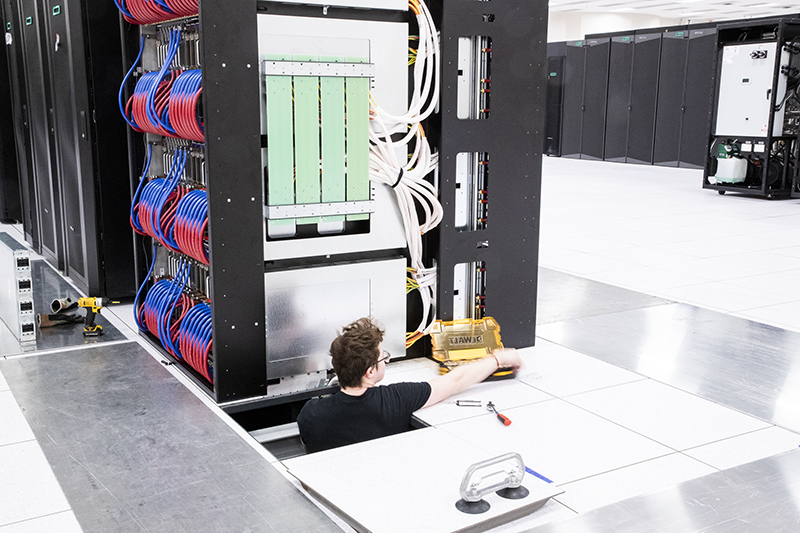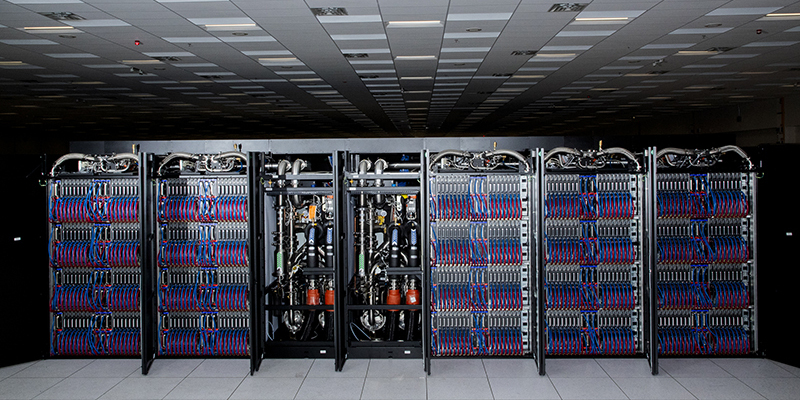Los Alamos National Laboratory with Hewlett Packard Enterprise (HPE) and Nvidia have combined on the design and installation of Venado (pictured here), the lab’s newest supercomputer.
Representatives from the U.S. Department of Energy, the National Nuclear Security Administration, Los Alamos, HPE and Nvidia joined others Monday, April 15, in cutting the ribbon on Venado, the new HPE Cray EX supercomputer with Nvidia GH200 Grace Hopper Superchips, at the laboratory’s Nicholas C. Metropolis Center for Modeling and Simulation.
Venado’s computing capacity will house 2,560 direct, liquid-cooled Grace Hopper Superchips in the exascale-class HPE Cray EX supercomputer. The system will also use 920 Nvidia Grace CPU Superchips, making it the first large-scale system with Nvidia Grace CPU superchips deployed in the United States. Nvidia packs 144 Arm cores in a Grace CPU Superchip to deliver an immediate performance boost to a wide range of HPC applications.
The lab said Venado was built to prioritize overall performance and workflow efficiency. The system is networked with HPE Slingshot 11 high-speed interconnect. Additional HPE Cray supercomputing software that leverages AI handles modeling and simulation workloads. Designed and manufactured in HPE’s facility in Chippewa Falls, Wisconsin, Venado takes its name from one of the highest peaks in New Mexico’s Sangre de Cristo Mountains.
The Nvidia Grace Hopper Superchips combine an Arm-based Nvidia central processing unit with an Nvidia Hopper architecture-based graphics processing unit to address high performance computing and giant-scale artificial intelligence applications. The superchips can execute millions more instructions per second, usually at lower cost and power consumption, than preceding chip technology. In early-scale tests Venado has shown significant results in atomistic simulations for materials science and high-resolution astrophysics simulations.
The system was delivered to Los Alamos in March.
“Venado adds to our cutting-edge supercomputing that advances national security and basic research, and it will accelerate how we integrate artificial intelligence into meeting those challenges,” said Thom Mason, director of Los Alamos National Laboratory.

Technicians install the Venado at Nicholas C. Metropolis Center for Modeling and Simulation, LANL
“Our supercomputing capabilities represent a critical component of how national laboratories tackle important problems,” said David Turk, deputy secretary of the U.S. Department of Energy. “With its ability to incorporate artificial intelligence approaches, we are looking forward to seeing how the Venado system at Los Alamos can deliver new and meaningful results for areas of interest.”
“As the first U.S. supercomputer powered by Nvidia Grace Hopper, the Venado system delivers groundbreaking performance and energy efficiency to accelerate scientific discovery,” said Ian Buck, vice president of hyperscale and HPC at Nvidia. “Through our continued work with Los Alamos and HPE, Venado will be a magnificent scientific instrument for researchers to achieve breakthroughs in materials science, renewable energy, astrophysics and more.”
“Powerful supercomputing with AI-driven capabilities will enable researchers to make high-impact breakthroughs and solve real-world problems in this next era of scientific discovery,” said Trish Damkroger, senior vice president and general manager, HPC & AI Infrastructure Solutions at HPE. “Los Alamos National Laboratory continues to demonstrate cutting-edge research and engineering achievements with industry-leading supercomputing. We are proud of our longstanding relationship with the Lab to build Venado, together with Nvidia, to deliver innovative AI solutions that will accelerate discoveries and make impactful contributions in fields like materials science and energy research.”
Venado is the outcome of a codesign process that will form the basis for ongoing collaboration focused on developing a broad spectrum of computing, memory and software technologies. Codesign draws on the combined expertise of vendors, hardware architects, system software developers, domain scientists, computer scientists and applied mathematicians working together to make informed decisions about hardware and software components.





Speak Your Mind